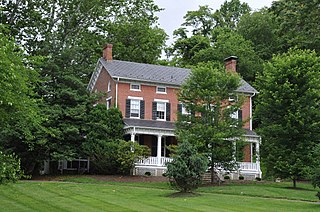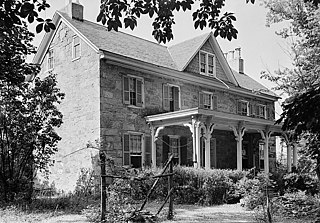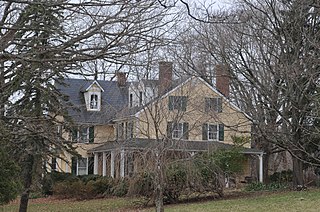Cardiff is an unincorporated community in Harford County, Maryland, United States. The zip code for the area is 21160. The community name is taken from the Capital city of Wales.

The Elkridge Furnace Complex is a historic iron works located on approximately 16 acres (6.5 ha) at Elkridge, Howard County, Maryland.

St. James Church is a historic Episcopal church located at Monkton, Baltimore County, Maryland, US.

Hidden Valley Farm is a historic home and farm complex located at Baldwin, Harford County, Maryland, United States. It consists of a mid-19th century vernacular Greek Revival brick farmhouse with several auxiliary structures. The house is a three-story, rectangular brick dwelling with a gable roof, with a two-story wing. The house features square-columned one-story porches across the façade and both sides of the wing. Also on the property are a mid-19th century barn, summer kitchen, and smokehouse, and later wood shed and garage.

Proctor House, also known as the Cassandra Gilbert House, is an historic home located at Bel Air, Harford County, Maryland, United States. It is a two-story detached Carpenter Gothic style cottage with board and batten siding, constructed between 1860 and 1873 and enlarged about 1884. The interior features an arched slate mantel painted to resemble several colors of inlaid marble.

Fair Meadows is a historic home located at Creswell, Harford County, Maryland. It is a 2+1⁄2-story Second Empire–style house constructed in 1868 for the last owner of Harford Furnace, Clement Dietrich. The house is constructed of irregularly laid ashlar and features a mansard roof, cupola, dormers with rounded hoods, and stone quoins. The interior has a center hall plan and includes intricate inlay designs, black and white marble tiles in the center hall, plaster ceiling ornaments and friezes, marble mantels, and original crystal chandeliers. Also on the property are the ruins of a round springhouse, a one-story stone carriage house, a brick smokehouse, and three hip-roofed coursed rubble stone outbuildings. The estate was later home to Eastern Christian College.

The Presbury Meetinghouse is a historic Methodist church located at Aberdeen Proving Ground, Harford County, Maryland, United States. The original portion of the building is a two-story brick structure and was built about 1720. It is approximately 40.5 feet by 20.25 feet. The building consists of a central hall with a room on either side on both floors. It is frequently mentioned in journals of early Methodist preachers and was the site of 14 visits for preaching and overnight rest by Bishop Francis Asbury between 1772 and 1777.

The Little Falls Meetinghouse is a historic Friends meeting house located at Fallston, Harford County, Maryland, United States. It was constructed in 1843 and is a sprawling one-story fieldstone structure with shallow-pitched gable roof and a shed-roofed porch. The building replaced an earlier meetinghouse built in 1773. Also on the property is a cemetery and a one-story frame mid-19th century school building, with additions made post-1898 and in 1975. It features the characteristic two entrance doors and a sliding partition dividing the interior into the men's and women's sides. The Friends currently meet on the former men's side of the meetinghouse, and the women's side is only used for large groups and special occasions.
Whiteford is an unincorporated community in Harford County, Maryland, United States. The community has historically had a strong Welsh heritage, which is reflected in the local architecture.

Bel Air Courthouse Historic District is a national historic district at Bel Air, Harford County, Maryland, US. It consists of a small cohesive group of buildings, mostly two or three stories of brick or frame construction that were erected or renovated in the 19th to early 20th century period and border the Harford County Courthouse which is a grand scale brick structure.

Berkley Crossroads Historic District is a historic district in Darlington, Maryland, United States. It is a small rural crossroads community dating from the late 18th century through the early 20th century, and is one of the few remaining rural crossroads in Harford County. The entire area is agricultural in nature, and mostly consists of two- and three-story residences. The earliest structures, dating from the late 18th and early 19th century are of log construction, in whole or in part. It was also an important 19th century Free Black community.

Darlington Historic District is a national historic district at Darlington, Harford County, Maryland, United States. It includes approximately 100 small-scale structures in the village of Darlington. They include four churches including the Darlington United Methodist Church and the Deer Creek Friends Meetinghouse, a dozen shops and stores, barns/garages, meathouses, chicken houses, and other outbuildings, a lodge hall, a grammar school, a cemetery, and three working farms. They date particularly from the late 19th century through the early 20th century.

Lower Deer Creek Valley Historic District is a national historic district near Darlington, Harford County, Maryland, United States. It comprises approximately 15,020 acres (60.8 km2) in north central Harford County. The primary building material is stone taken from local quarries and used to construct houses, mills, schoolhouses, and churches. Also constructed of stone are many dependencies including springhouses, stables, tenant houses, meathouses, ice houses, and barns. The district's contributing standing structures date from the mid 18th century to the 1940s, and mostly built in vernacular styles. The valley contains approximately 350 separate historic properties.

Silver Houses Historic District is a national historic district near Darlington, Harford County, Maryland, United States. It is a group of mid-19th century farmsteads and a church in rural east central Harford County. The district comprises a total of 36 resources, including four stone residences with related agricultural outbuildings, and the site of a fifth stone house, marked by a large frame barn, a frame tenant house, and two outbuildings. The houses were built between 1853 and 1859 by members of the Silver family. The district also includes the Deer Creek Harmony Presbyterian Church, a Gothic-influenced stone building of 1871, designed by John W. Hogg.

Finney Houses Historic District is a national historic district near Churchville, Harford County, Maryland, United States. It stretches along both sides of Glenville Road in central Harford County, Maryland. The district takes in four houses and their outbuildings erected by members of the locally important Finney family between 1821 and 1906.

Medical Hall Historic District is a historic home and national historic district near Churchville, Harford County, Maryland, United States. The home was constructed of stuccoed stone between 1825 and 1840 and is five bays long, two bays wide, and two and a half stories high. The façade features a centrally placed door with sidelights and a rectangular transom subdivided in a radiating pattern. Also on the property is a stone springhouse which 20th century owners have converted into a pumphouse and a stone cottage believed to be a 19th-century tenant house. The property is associated with John Archer (1741–1810), the first man to receive a degree in medicine in America. One of his sons was Congressman, judge of the circuit court, and Chief Justice of Maryland Stevenson Archer (1786–1848).

Havre de Grace Historic District is a national historic district at Havre de Grace, Harford County, Maryland, United States. It is an urban district of approximately a thousand buildings and includes the central business district and most of the residential neighborhoods radiating out of it. The buildings date primarily from the 19th and early 20th centuries.

The Southern Terminal, Susquehanna and Tidewater Canal is a national historic district at Havre de Grace, Harford County, Maryland, United States. Located along the western bank of the Susquehanna River near its mouth at the Chesapeake Bay, it includes the Lock Master's House, the canal's outlet lock, and the foundations of a bulkhead wharf along the river side of the lock. Most of the structures built to serve aspects of the Susquehanna and Tidewater Canal operations are no longer standing, but the locations of warehouses, stables, and several other buildings, including a broom factory, are shown on old city maps.

Whitaker's Mill Historic District is a national historic district near Joppa, Harford County, Maryland, United States. It includes three early- to mid-19th-century buildings: the 2+1⁄2-story rubble stone Whitaker's Mill built in 1851, the 1+1⁄2-story rubble stone miller's house, and the log-and-frame Magness House, begun about 1800 as the miller's house for the first mill on the site. The district also includes an iron truss bridge known as Harford County Bridge No. 51, constructed in 1878, and the oldest such span in the county. The grist mill closed operations about 1900.

Whiteford–Cardiff Historic District is a national historic district at Cardiff and Whiteford, Harford County, Maryland, United States. It encompasses portions of two communities in northern Harford County that were historically associated with slate production during the late 19th and early 20th centuries. It contains 140 contributing resources including four vernacular Welsh cottages dating to about 1850. The Whiteford–Cardiff area is noted for its strong Welsh ethnic identity, which is reflected in the architecture of the area.






















